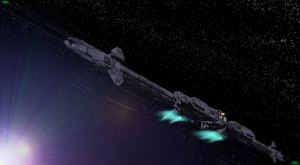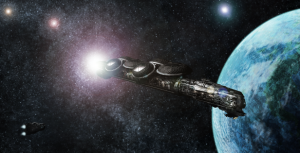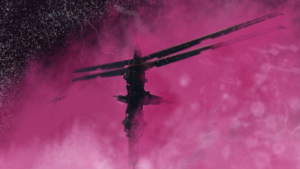Участник:NewOriginalSchwann/Sandbox

The largest representation of offworlder humans, the Scarabs are a loosely-organized confederation of nomadic vessels which spent decades isolated from the rest of humanity in the uncharted frontier due to the Interstellar War. The Scarabs are a population of hardy survivors who are adept at surviving in the void of space and possess a unique culture which is a result of their decades of isolation in the frontier, where a single mistake could spell death.
Scarabs traditionally have two surnames, with the first being a family name and the second being the vessel the Scarab originates upon.
History
What would become the modern Scarab Fleets has its roots in what the Solarian government referred to as Colony Fleet SFE-528-RFS, or Solarian Frontier Expedition #528 (Riphean Frontier Sector). Fleet 528 was organized by the Solarian Department of Colonization and intended to serve as an initial survey and colonization fleet in the Riphean Frontier Sector. Intended to be launched in 2268, several years after the start of the Second Great Depression, the Fleet was ultimately granted a significantly smaller budget than originally anticipated due to the unexpected economic collapse of the Solarian economy. The bureaucrats in the Solarian government responsible for its funding, desperate to save money wherever they could, cut what they believed would be the least important aspect of the ships: their gravity generators. These were, after all, a large expense and would only be needed for a few years before Fleet 528’s vessels reached the Riphean Frontier Sector (modern-day Arusha) and established a presence on worlds which already had gravity. It simply made economic sense to divert the funding, and strip the machinery out.
At the time of its launch in 2268 Fleet 528 was expected to reach the Central Solarian Frontier (the modern Coalition) by the early 2270s, and would reach the Riphean Frontier Sector by the mid-2270s. Long-range communication by the Fleet would have to rely upon interstellar communication stations throughout the Solarian Alliance. These stations, while primitive and clunky by the standards of the 25th century, would ensure the Fleet remained in contact with the Alliance and received updates from them such as stellar navigation assistance — a critical component of remaining on-course in the mostly uncharted frontier they were located in. Without this, the Fleet would quickly find themselves lost in a hostile region which had only been previously explored by survey drones.
Disaster struck the Fleet in 2275 with the outbreak of the Interstellar War. As Solarian turned against Solarian and the Spur plunged into its largest recorded war, the communication and navigation relays the Fleet relied upon for communication and navigation became hotly contested points of conflict between the Solarian Navy and the Coalition’s forces. By late 2275 most had been destroyed, either deliberately or as a result of combat, and those that survived were largely rendered unusable as a result of the Solarian Navy changing the encryption protocols. The Fleet, already isolated in the far flung reaches of the Riphean Frontier Sector, had no way of receiving these codes, and found itself cut off from communication, navigation, and the occasional autonomous resupply fleets sent to it by the Department of Colonization. The ships of the Fleet, designed for survey work, were rugged and durable, but found themselves stuck in a dire situation where they were deprived of supplies, navigational assistance, and cut off from any way to call for help. The Fleet’s captains initially settled upon a logical course of action: isolated as they were, and with their ships lacking gravity generators, the most sensible course of action was to find a planet to settle on before supplies ran out or the Fleet’s members, who had lived in low gravity for nearly a decade, became too physically weak to readapt to life in gravity.
Months became years as the Fleet searched for a habitable world in the Riphean Frontier Sector to little success, with most worlds being far too wild and untamed for them to reasonably survive on in their weakened states from years of low-gravity living. Planet after planet and system after system were discovered, charted, and marked as unsuitable for habitation by the Fleet as it wandered further and further through the uncharted frontier, having no contact with any outside itself. The Interstellar War had ended and the Solarian Alliance had experienced a disastrous attempted coup in the meantime, but these developments were utterly irrelevant to the Fleet, alone in its blind journey. As the 23rd century became the 24th and the Fleet continued to wander, its culture — which had started with the sense of ruggedness typical of those who volunteered for such a daring task as colonizing an alien world — began to shift and, as the first generation to be born in zero gravity appeared and those who could not adapt to their new environment began to either die or be left behind, the nature of the Fleet gradually changed.
The children born to the Fleet instead of having boarded its ships at the beginning of its journey developed substantial anatomical differences from those who preceded them as a result of spending their entire lives in zero gravity. These physical distinctions became the typical traits of those who would become, in time, the entire population of the fleet; the so-called “offworlders.” The need to preserve their ships, which grew older and less reliable every year, turned their culture of ruggedness into a culture of dogged survival and endurance against all odds. Unnecessary systems were scrapped and cannibalized, nonfunctional vessels were broken and all usable components were integrated into those ships still able to carry on. The number of ships in the Fleet slowly decreased and the remaining members, perhaps to acknowledge how scavenging had become the foundation of their very existence, began to refer to themselves as the Scarabs.
The Fleet would remain cut off from the broader Spur until 2398, when their wanderings brought them across a long-abandoned Coalition-flagged Oslo-class battleship which had been lost during the Interstellar War. This vessel, which had been adrift for over a century by the time of its discovery by the Scarab Fleet, was the first encounter they had had with the broader Orion Spur in generations. Although adrift for more than a century and forgotten by those to whom it had served, the battleship was home to an incredible boon for the Scarabs: a functional military-grade navigation computer which would allow them to navigate the Fleet back to civilization. Salvation at long last! The Scarab vessels, abuzz with excitement at their potential salvation, eagerly went to work disassembling the battleship and bringing its navigation system onto their flagship, the Riphean Voyager. Some voiced concern about reentering broader humanity after a century, while others believed all but the Scarabs had been decimated during this newly-discovered conflict, and that they were all that remained of civilization in the spur. Ultimately more captains voted to return to humanity than voted to remain isolated on their slowly decaying vessels, and the Scarabs began their journey from the uncharted frontier and back into the world their forebears had left behind.
The return journey would take the Scarabs twenty years, and they would only arrive at the Coalition’s border in 2418. Their first contact with broader humanity was at the Coalition’s frontier with Arusha, where they were met with a combined Coalition force mostly consisting of All-Xanu Republic vessels which had been scrambled in response to a large number of unknown ships entering Coalition space from an uncharted frontier region. Detection by early warning sensor stations along the Coalition’s border caused a significant force — the largest such to exist between the Interstellar War and the Solarian Civil War, which had gripped the Northern Wildlands in 2465 — to be assembled, but failed to prepare the Coalition unexpectedly peaceful (if not entirely friendly) Scarabs as they emerged from their isolation. A violent engagement was averted by quick diplomacy from both sides and the Scarab Fleet, as it was now formally known, was welcomed into the Coalition as a new, and unique, form of government.
Since 2418 the Scarabs have slowly readjusted to life in a very different Orion Spur than the one they left, and many have struggled — or failed — to fully integrate with this new world. As the years go on and the Scarabs born having never known their years as true wanderers begin to outnumber their aging peers who have known nothing other than the Fleet, some worry their unique culture and way of life will fade away. But only time will tell what the future holds for the Spur’s largest offworlder population.
Government and Politics
The Scarab Fleet operates under a system of government only slightly more unified than the Coalition it is a part of. As a highly decentralized group of ships, united only by their shared purpose and vision, they have a very loose structure, almost reminiscent of an old feudal structure. At the very top of Scarab society is the Fleet Director, in charge of both the day to day operations of the Scarab Fleet as well as its future direction. Fleet Directors serve for ten years per term and the current Fleet Director is Rajendra Dube Riphea, captain of the Riphean Voyager. The Fleet Director oversees a collection of Grand Captains who command flotillas of ten to fifty ships, and below them, the individual captains of the ships. The body comprising all of these captains is known as the Conclave, often convening aboard the Riphean Voyager, to vote on major issues concerning the whole Fleet, and most importantly, appoint or offer counsel to the Fleet Director and the Grand Captains, with all captains from the Fleet Director to the lowliest freighter operator receiving a single vote.
Very few issues reach the level where they are discussed in the Conclave, continuing to remain in the Coalition being one of them. From concerns of defense against piracy to the expansion of farming space aboard ships, only one issue has repeatedly been debated and inconclusively argued in every single Conclave: the final destination of the Scarabs. The heated discussion has coalesced into two major camps: those that believe the Scarabs should continue the ways of their ancestors, sighting the immense flexibility and self-reliance it has given them, and those that believe they should settle down, seeking to bring to life the dream of entire civilizations living in artificial habitats written up by humanity centuries ago.
Recently however, in hushed whispers, a third bloc has been gaining traction: those that believe the place of the Scarabs is neither sailing amongst the civilizations of the Spur nor finding a place to settle down among them. Emboldened by the arrival of the Vaurca from outside the Spur, they argue that the original mission of the Scarabs can still be accomplished. Rather than risk annihilation in an Intergalactic War in the Orion Spur, they seek to stockpile resources to begin a new voyage and instead push humanity’s borders ever outwards to ensure its continued survival. Curiously, the current Fleet Director has remained silent on the matter, both simultaneously infuriating the entirety of the Conclave, and spends much of his time serving as a perfect mediator between the myriad factions of the Scarabs.
The basic unit of Scarab society is a ship - the day to day life of a Scarab will be governed by their ship and more specifically, its captain. Captains are given vast autonomy to run their ships as they see fit, so long as it does not endanger the larger fleet. Under this system the only real obligations a captain has are to obey the orders of the Fleet Director and to return to aid the Fleet in a time of emergency. Inevitably, laws and customs vary from ship to ship and can oftentimes be more unspoken than written.
The succession of captaincy onboard ships usually operates on appointment of a successor, but for the sake of stability, many vessels have simply adopted a system of hereditary command with the ability for an heir to refuse if they feel unfit, the ship then deciding how to proceed from there. The cultural aspects of Scarab life have ensured that this is frowned upon. It would be mistaken to assume however that a captain has unlimited power - they have to command their ships with the consent of the crew, as although rare, it is not unheard of for a captain to be removed, such a feat being possible with the assent of the Conclave.
This loose system where anything goes has necessarily resulted in the upper echelons of the Fleet being tolerant to ships that skirt the laws of whatever system they happen to be in. With the cohesion and commitment of the Scarabs to the fleet prized above all else, a few stolen goods or the occasional asteroid mined without a permit have to be overlooked.
While most spectators would fear for the continued existence of the Scarabs given such a political system, the fact that it is so easy for a ship to slip away from the great mission does not concern the Scarabs. If a crew abandons the Fleet, then it simply means they were not prepared for the trials that lay ahead.
Interstellar Relations
Although a part of the Coalition of Colonies, the Scarabs’ unique cultural and geographical situation has ensured that it has never marched lock-and-step with the rest of the Coalition’s planets. In general, the Conclave has maintained a single guiding philosophy with their relationships - to make as many friends as possible, and incur as few obligations as it can. Therefore, in order to increase their chances of survival in an increasingly dangerous Spur, the Scarab Fleet maintains a web of close, overlapping, and oftentimes contradictory alliances with as many nations as possible. Many Scarabs feel a degree of personal loyalty to the Coalition due the commonly utilized ESS RIGsuit originating in its borders and being sold to the Scarabs at below-market prices.
In particular, the Scarab Fleet has maintained a strange relationship with the Sol Alliance. Although too far away from each other to truly have any day to day interactions, many in the Fleet have always resented the lack of investment Sol placed in its original ships. However, many appreciate the venerated and ancient automated supply ships that kept the Scarabs alive in their early days, and this appreciation has become part of the Scarabs’ oral history. While the two officially interact through the larger Coalition of Colonies, it is not uncommon for individual Scarabs or single ships to find work in the Alliance before returning to the larger fleet, with their expertise in space being exploited to pick up the logistic slack caused by the current Collapse.
The Scarabs also maintains a healthy trade relationship with the Republic of Elyra. As a spacefaring nation dependent on fuel to preserve their way of life, they have found a reliable phoron supplier in the Republic, and in turn, Elyra has received a loyal customer and occasional technological exchange partner. This friendship in the south of the Spur has strangely extended to the Empire of Dominia, with the monarchy respecting both their resilience, and seeing kindred spirits in the quasi-hereditary captains of the Fleet.
It is a matter of survival for the fleet to maintain relationships with the Republic of Biesel and the megacorporations that back it. Despite their massive strides towards self-reliance, the Scarabs are still dependent on trade to maintain, and more crucially, expand and refit their aging vessels. Although the megacorporations have seen the opportunity provided by the Scarabs, they have refrained from exploiting it as the decentralized nature of the Fleet means they are unable to strike up any lasting deals. The melting pot nature of the Republic has seen it become a favored destination of many exiles however, with many Sadars going on to find work and even citizenship in the CRZ.
With an emphasis on trade and space travel in their alliances, it seems counterintuitive that the Scarabs would have a fraught and unsteady relationship with their neighbors in Arusha, the Golden Deep. This difference comes down more to ideological than practical concerns, with the capitalistic and avaricious nature of the merchant collective contrasting with the collectivist and conservationists attitudes of the Scarabs. Both groups need to work together to survive in the alien region however, and many captains can recount stories of Golden Deep merchants providing life-saving top-ups of oxygen and fuel supplies, even as all of the ship’s militia were mustered out to ensure nothing was stolen.
Despite all of these relationships, the Scarabs’ most important ally in the Spur remains to be the Coalition of Colonies. It is a symbiotic relationship, with the Coalition providing a permanent berth for the Fleet as it prepares for its journey while the Scarabs provide substantial technological and naval assistance, in particular helping to sustain the fringe worlds on its outskirts. While enjoying a special relationship with Xanu, its initial sponsor in the Coalition, things have always been frigid with Gadpathur, who detest the Fleet’s dealing with Sol, and Assunzione, who often have to deal with the Scarabs dumping their unruly exiles in the area whenever they visit the Light’s Edge.
Mayfly

A ship originated from the Falklands. Colonists from this ship stick to the colors of blue, white and red. They’re primarily caucasian, this ship is known for some of the best engineers and sailors.
An oddity in design, the Mayfly was a failed prototype purchased by Einstein Engines a year after its construction in 2201. The vessel itself was meant to be a garbage swoop originally, mopping Earth’s orbit of its dangerous hyper-accelerated debris. Competitors from Einstein were one step ahead however, and upon purchasing the vessel, it was converted into a heavy-duty freighter. At 1105 meters in width, the vessel resembles a very long, sideways stick with engines strapped on and cargo departments dangling from beneath. Now, almost 50,000 people call it home.
Impukane
A Central African originating ship, the Impukane is known for its cooking and strong security force. The Scarabs from these ships would prefer colors like green, orange and red. People from these ships are primarily Central African.
A largely untouched warp battleship at nearly 730 meters long, the Impukane is one of the largest vessels in the Scarab home fleet. Its intimidating, spikey mass may look dangerous at first glance, but the ship has over time become nothing more than a garrison for much of the official defense force the Scarabs may have. It routinely deploys assistance to fellow vessels for a myriad of reasons and holds a substantial prison wing that contains almost the entirety of the fleet’s own criminals. Its population has plummeted in recent years, now around 65,000.
Fa’Ta-Bs
(Faladay Tadhhab Bsre) is a ship contributed by the Levant. They’re known for their excellent medical practitioners. Their official colors are white, blue and black. People from this ship are usually of Arabic or Jewish descent.
Built with parts sent to space from the largest coil gun ever created, the Fa’Ta-Bs is a marvel of engineering from the 2200’s. The ship itself is relatively small in terms of the fleet, with a population of 11,300, but it also carries the fleet’s foremost medical supplies and response equipment. There are few children if at all kept on board the ship itself, with those on board explicitly being workers for the fleet.
Su-Yeongseon
The Su-Yeongseon is a vessel with roots from eastern Asian, namely Korean descent who had branched off from an international effort to colonize the Antarctic in the early 2200’s. They are well known for their atmospheric manipulation and engineering prowess.
From the newly-founded city designated Sierra Peak, the world’s largest Antarctic colony sprouted an effort to redirect the incredibly advanced environment control and habitation techniques into space. This was seen as a massive success to the Scarabs later down the line, with many of the tricks seen in surviving the harsh tundras now being used to preserve lives on board Scarab vessels. The forefront of this advanced study is the Su-Yeongseon, a large warp cruiser, built in 2197 and now retrofitted for bluespace travel that originally departed with the fleet for defensive purposes. Over time it was converted into an engineering warehouse, with many of its drone bays and missile silos now serving as hangars and storage compartments. The ship itself was built to hold 22,000 people at maximum, but over time has grown to have a population of 42,000 or more with space to spare thanks to modification.

San-Khöl
(Sansryn Khölög) is a Mongolian originating ship. Colonists from this ship primarily enjoy the colors of red, blue, and yellow. They are known for their gardeners, hydroponicists, and scientists. People from this ship are usually of Mongolian or Chinese descent. Built over the course of five years in Ulaanbaatar, the 1100 meter long San-Khöl is an impressive hydroponics vessel. Although capable of holding roughly 25,000 passengers, most of the available space on-board is dedicated to storage of water, food processing, and most importantly the eight hydroponics domes installed onto the ship’s exterior. These are used for fruits, vegetables, and most importantly insects. Three varieties of insect are the most raised here, the Hakhma, a massive beetle the size of a small car. These are utilized for their feed to meat ratio and friendly disposition. Secondly, the Süüs, a variety of honeypot ant that are soda-can sized. These are typically fed cactus juice, which the ant processes into an edible, reportedly tasty and highly nutritious juice, often seen hanging from a Scarab’s belt. Lastly various species of spider, used for their high-strength silk. The ninth dome is entirely devoid of such hydroponics, being used primarily for theatre and entertainment.
Bilröst, Jörmungandr and Jötunheimr


The CCV Bilröst and Jörmungandr are two ships contributed by the former Scandinavian Coalition. This group was formed around the year 2015 in response to the collapse of the European Union. The countries of Denmark, Norway, and Sweden hastily turned to each other for stability, reforming a modern version of the Scandinavian Monetary Union. Eventually the Bilröst was constructed in the year 2129, and the Jötunheimr in 2130. However, the plan was malformed. Certain aspects of the ship were under-engineered, certain systems were lacking in redundancies and backups, and an overall lack of strategy regarding reaching the promised land the Confederation had purchased. The addition of the escort ship, Jörmungandr, only complicated affairs, and not long after their launch, the Scandinavian Coalition was in the red.
With so much of the Coalition’s focus on the new space faring vessels, its people fell to the wayside. Citizens of the Coalition faced food shortages, lack of available healthcare, and an increasing difficulty in finding good work. Times were dark, and with such unpleasant circumstances, there was one thing humans historically turned to - religion.
And it was thus that the people of the Coalition started to look to their old ways.
The people of the Coalition filled themselves with forgotten gods and culture, and it was thanks to this that they gained the strength that they needed to see themselves through adversity. They persevered, worked with what they had, and created the means aboard their new ships to end hunger and heal the sick - and it was in this way that they grew in purpose.
Bilröst
The CRV Bilröst (Bifröst) was the first ship constructed by the Scandinavian coalition. Named after the burning rainbow bridge connecting Midgard and Asgard, the most important activities performed aboard the Bilröst are of the scientific variety, as well as medical work being split between here and the Jörmungandr. Here, important research is performed to enhance the Offworlder quality of living; musculoskeletal and immune system supplements, different types of bracing equipment, and even the first ESS prototype have undergone development here. Lastly, branching off chemical-based tomfoolery in the early days, the Bilröst is known across the flotilla for their excellent skills in making various confectionery products, especially candy and chewing gum.
Jörmungandr
The CEV Jörmungandr is a satellite of sorts that accompanies the Bilröst. Named after the Midgard Serpent surrounding the Earth, it is significantly smaller in size, and is only used for non-civilian purposes. The main function of Jörmungandr is to handle and observe security scans to protect the main vessel. Access to the Jörmungandr is normally restricted to capable operators. Typically personnel here are either of an investigative nature, the temporary holding of criminals, or the maintenance and operation of various drones and robots, combat or otherwise. The Jörmungandr also keeps a small retinue of medical staff freely available to all Scarabs.
Jötunheimr
The CCV Jötunheimr (Jotunheim) was the last ship constructed by the Scandinavian coalition, and the largest of the three, the ‘center of life’ for them, and holds the highest population; owing to possessing the most residential space. Named after the ancestral homeland of the Jötnar, typical work aboard the Jötunheimr is the everyday logistics, mineral recovery, salvage, beekeeping, hydroponics and service/cooking that keeps the flotilla going. The Jötunheimr partakes in trading and exports such goods as minerals, confectionery products, equipment made on the Bilröst, and so on. Due to the harsh work aboard this vessel, the residents tend to be the fittest both spiritually and physically, the vessel boasting both elaborate fitness complexes, and places for group gatherings and rituals. While the passion the Scarabs here have for their work is praiseworthy, the feasts are legendary.







